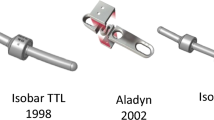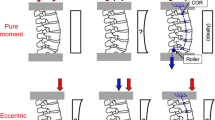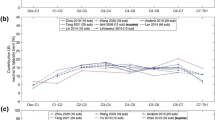Abstract
Purpose
While much evidence suggests that adjacent segment degeneration is merely a manifestation of the natural degenerative process unrelated to any spine fusion, a significant body of literature supports the notion that it is a process due in part to the altered biomechanics adjacent to fused spine segments. The purpose of this study was to review and critically analyze the published literature that investigated the in vivo kinematics of the adjacent segments and entire lumbar spine in patients receiving spinal fusion or motion-preserving devices.
Methods
A systematic review of the PubMed database was conducted, initially identifying 697 studies of which 39 addressed the in vivo kinematics of the segments adjacent to spinal implants or non-instrumented fusion of the lumbar spine.
Results
Twenty-nine articles studied fusion, of which three reported a decrease in range of motion of the caudal adjacent segment post-fusion. Examining the rostral adjacent segment, twelve studies observed no change, nine studies found a significant increase, and three studies reported a significant decrease in sagittal plane range of motion. Of the six studies that analyzed motion for the entire lumbar spine as a unit, five studies showed a significant decrease and one study reported no change in global lumbar spine motion. Kinematics of the segment rostral to a total disc replacement was investigated in six studies: four found no change and the results for the other two showed dependence on treatment level. Fifteen studies of non-fusion posterior implants analyzed the motion of the adjacent segment with two studies noting an increase in motion at the rostral level.
Conclusions
There appears to be no overall kinematic changes at the rostral or caudal levels adjacent to a fusion, but some patients (~20–30 %) develop excessive kinematic changes (i.e., instability) at the rostral adjacent level. The overall lumbar ROM after fusion appears to decrease after a spinal fusion.


Similar content being viewed by others
References
Lund T, Oxland TR (2011) Adjacent level disk disease—is it really a fusion disease? Orthop Clin N Am 42:529–541. doi:10.1016/j.ocl.2011.07.006 (viii)
Park P, Garton HJ, Gala VC et al (2004) Adjacent segment disease after lumbar or lumbosacral fusion: review of the literature. Spine (Phila Pa 1976) 29:1938–1944
Penta M, Sandhu A, Fraser RD (1995) Magnetic resonance imaging assessment of disc degeneration 10 years after anterior lumbar interbody fusion. Spine (Phila Pa 1976) 20:743–747
Wai EK, Santos ERG, Morcom RA, Fraser RD (2006) Magnetic resonance imaging 20 years after anterior lumbar interbody fusion. Spine (Phila Pa 1976) 31:1952–1956
Korovessis P, Repantis T, Zacharatos S, Zafiropoulos A (2009) Does Wallis implant reduce adjacent segment degeneration above lumbosacral instrumented fusion. Eur Spine J 18:830–840. doi:10.1007/s00586-009-0976-y
Kaito T, Hosono N, Mukai Y et al (2010) Induction of early degeneration of the adjacent segment after posterior lumbar interbody fusion by excessive distraction of lumbar disc space. J Neurosurg Spine 12:671–679. doi:10.3171/2009.12.SPINE08823
Panjabi M, Malcolmson G, Teng E et al (2007) Hybrid testing of lumbar CHARITE discs versus fusions. Spine (Phila Pa 1976) 32:959–966
Strube P, Tohtz S, Hoff E et al (2010) Dynamic stabilization adjacent to single-level fusion: Part I. Biomechanical effects on lumbar spinal motion. Eur Spine J 19:2171–2180
Nagata H, Schendel MJ, Transfeldt EE, Lewis JL (1993) The effects of immobilization of long segments of the spine on the adjacent and distal facet force and lumbosacral motion. Spine (Phila Pa 1976) 18:2471–2479
Molz FJ, Partin JI, Kirkpatrick JS (2003) The acute effects of posterior fusion instrumentation on kinematics and intradiscal pressure of the human lumbar spine. J Spinal Disord Tech 16:171–179
Weinhoffer SL, Guyer RD, Herbert M, Griffith SL (1995) Intradiscal pressure measurements above an instrumented fusion: a cadaveric study. Spine (Phila Pa 1976) 20:526–531
Volkheimer D, Malakoutian M, Oxland TR, Wilke H-J (2015) Limitations of current biomechanical in vitro test protocols for investigation of the adjacent segment degeneration due to spinal instrumentation. Critical analysis of the literature. Eur J Spine (accepted)
White AA, Panjabi MM (1990) Clinical biomechanics of the spine. Lippincott Philadelphia
Nakai S, Yoshizawa H, Kobayashi S (1999) Long-term follow-up study of posterior lumbar interbody fusion. J Spinal Disord Tech 12:293–299
Zigler J, Glenn J, Delamarter R (2012) Five-year adjacent-level degenerative changes in patients with single-level disease treated using lumbar total disc replacement with ProDisc-L versus circumferential fusion. J Neurosurg Spine 1–8 17:504–511. doi:10.3171/2012.9.SPINE11717
Aota Y, Kumano K, Hirabayashi S (1995) Postfusion instability at the adjacent segments after rigid pedicle screw fixation for degenerative lumbar spinal disorders. J Spinal Disord Tech 8:464–473
Anderst WJ, Vaidya R, Tashman S (2008) A technique to measure three-dimensional in vivo rotation of fused and adjacent lumbar vertebrae. Spine J 8:991–997. doi:10.1016/j.spinee.2007.07.390
Ohtori S, Yamashita M, Inoue G et al (2010) Rotational hypermobility of disc wedging using kinematic CT: preliminary study to investigate the instability of discs in degenerated scoliosis in the lumbar spine. Eur Spine J 19:989–994
Ochia RS, Inoue N, Renner SM et al (2006) Three-dimensional in vivo measurement of lumbar spine segmental motion. Spine (Phila Pa 1976) 31:2073–2078
Beastall J, Karadimas E, Siddiqui M et al (2007) The Dynesys lumbar spinal stabilization system: a preliminary report on positional magnetic resonance imaging findings. Spine (Phila Pa 1976) 32:685–690
Tashman S, Anderst W (2003) In-vivo measurement of dynamic joint motion using high speed biplane radiography and CT: application to canine ACL deficiency. Trans Soc Mech Eng J Biomech Eng 125:238–245
Wang S, Passias P, Li G et al (2008) Measurement of vertebral kinematics using noninvasive image matching method-validation and application. Spine (Phila Pa 1976) 33:E355–E361. doi:10.1097/BRS.0b013e3181715295
Kapron AL, Aoki SK, Peters CL et al (2013) Accuracy and feasibility of dual fluoroscopy and model-based tracking to quantify in vivo hip kinematics during clinical exams. ASME 2013 Summer Bioengineering Conference American Society of Mechanical Engineers, pp V01BT38A006–V01BT38A006
Bey MJ, Zauel R, Brock SK, Tashman S (2006) Validation of a new model-based tracking technique for measuring three-dimensional, in vivo glenohumeral joint kinematics. J Biomech Eng 128:604–609
Anderst W, Zauel R, Bishop J et al (2009) Validation of three-dimensional model-based tibio-femoral tracking during running. Med Eng Phys 31:10–16
Ishii T, Mukai Y, Hosono N et al (2004) Kinematics of the upper cervical spine in rotation: in vivo three-dimensional analysis. Spine (Phila Pa 1976) 29:E139–E144
Rogers BP, Haughton VM, Arfanakis K, Meyerand ME (2002) Application of image registration to measurement of intervertebral rotation in the lumbar spine. Magn Reson Med 48:1072–1075
Lim T-H, Eck JC, An HS et al (1997) A noninvasive, three-dimensional spinal motion analysis method. Spine (Phila Pa 1976) 22:1996–2000
Zhao K, Yang C, Zhao C, An K-N (2005) Assessment of non-invasive intervertebral motion measurements in the lumbar spine. J Biomech 38:1943–1946. doi:10.1016/j.jbiomech.2004.07.029
Johnsson R, Selvik G, Strömqvist B, Sunden G (1990) Mobility of the lower lumbar spine after posterolateral fusion determined by roentgen stereophotogrammetric analysis. Spine (Phila Pa 1976) 15:347–350
McGregor AH, Anderton L, Gedroyc WMW et al (2001) Assessment of spinal kinematics using open interventional magnetic resonance imaging. Clin Orthop Relat Res 392:341–348
Lim MR, Loder RT, Huang RC et al (2006) Measurement error of lumbar total disc replacement range of motion 31:291–297
Cakir B, Richter M, Puhl W, Schmidt R (2006) Reliability of motion measurements after total disc replacement: the spike and the fin method. Eur Spine J 15:165–173
Pearson AM, Spratt KF, Genuario J et al (2011) Precision of lumbar intervertebral measurements: does a computer-assisted technique improve reliability? Spine (Phila Pa 1976) 36:572–580
Park S-A, Ordway NR, Fayyazi AH et al (2009) Comparison of Cobb technique, quantitative motion analysis, and radiostereometric analysis in measurement of segmental range of motions after lumbar total disc arthroplasty. J Spinal Disord Tech 22:602–609. doi:10.1097/BSD.0b013e318198791e
Frymoyer JW, Hanley EN Jr, Howe J et al (1979) A comparison of radiographic findings in fusion and nonfusion patients ten or more years following lumbar disc surgery. Spine (Phila Pa 1976) 4:435–440
Seitsalo S, Schlenzka D (1997) Disc degeneration in young patients with isthmic spondylolisthesis treated operatively or conservatively: a long-term follow-up. Eur Spine J 6:393–397
Luk KD, Chow DH, Evans JH, Leong JC (1995) Lumbar spinal mobility after short anterior interbody fusion. Spine (Phila Pa 1976) 20:813–818
Auerbach JD, Wills BPD, McIntosh TC, Balderston RA (2007) Evaluation of spinal kinematics following lumbar total disc replacement and circumferential fusion using in vivo fluoroscopy. Spine (Phila Pa 1976) 32:527–536. doi:10.1097/01.brs.0000256915.90236.17
Leferink VJM, Zimmerman KW, Nijboer J et al (2002) Thoracolumbar spinal fractures: segmental range of motion after dorsal spondylodesis in 82 patients: a prospective study. Eur Spine J 11:2–7
Kamioka Y, Yamamoto H (1990) Lumbar trapezoid plate for lumbar spondylolisthesis: a clinical study on preoperative and postoperative instability. Spine (Phila Pa 1976) 15:1198–1203
Delamarter RB, Fribourg DM, Kanim LEA, Bae H (2003) ProDisc artificial total lumbar disc replacement: introduction and early results from the United States clinical trial. Spine (Phila Pa 1976) 28:S167–S175. doi:10.1097/01.BRS.0000092220.66650.2B
Auerbach JD, Jones KJ, Milby AH et al (2009) Segmental contribution toward total lumbar range of motion in disc replacement and fusions: a comparison of operative and adjacent levels. Spine (Phila Pa 1976) 34:2510–2517. doi:10.1097/BRS.0b013e3181af2622
Chou W-Y, Hsu C-J, Chang W-N, Wong C-Y (2002) Adjacent segment degeneration after lumbar spinal posterolateral fusion with instrumentation in elderly patients. Arch Orthop Trauma Surg 122:39–43
Cakir B, Carazzo C, Schmidt R et al (2009) Adjacent segment mobility after rigid and semirigid instrumentation of the lumbar spine. Spine (Phila Pa 1976) 34:1287–1291. doi:10.1097/BRS.0b013e3181a136ab
Hu Y, Gu Y, Xu R et al (2011) Short-term clinical observation of the Dynesys neutralization system for the treatment of degenerative disease of the lumbar vertebrae. Orthop Surg 3:167–175. doi:10.1111/j.1757-7861.2011.00142.x
Kong D, Kim E, Eoh W (2007) One-year outcome evaluation after interspinous implantation for degenerative spinal stenosis with segmental instability. J Korean Med Sci 22:330–335
Ordway NR, Fayyazi AH, Abjornson C et al (2008) Twelve-month follow-up of lumbar spine range of motion following intervertebral disc replacement using radiostereometric analysis. SAS J 2:9–15. doi:10.1016/S1935-9810(08)70012-4
Tournier C, Aunoble S, Le Huec JC et al (2007) Total disc arthroplasty: consequences for sagittal balance and lumbar spine movement. Eur Spine J 16:411–421. doi:10.1007/s00586-006-0208-7
Siepe CJ, Hitzl W, Meschede P (2009) Interdependence between disc space height, range of motion and clinical outcome in total lumbar disc replacement. Spine (Phila Pa 1976) 34:904–916
Shim CS, Lee S, Shin H, Kang HS (2007) CHARITE Versus ProDisc charite : a comparative study of a minimum 3-year follow-up. Spine (Phila Pa 1976) 32:1012–1018
SariAli E, Lemaire JP, Pascal-Mousselard H et al (2006) In vivo study of the kinematics in axial rotation of the lumbar spine after total intervertebral disc replacement: long-term results: a 10–14 years follow up evaluation. Eur Spine J 15:1501–1510. doi:10.1007/s00586-005-0016-5
Leivseth G, Braaten S, Frobin W, Brinckmann P (2006) Mobility of lumbar segments instrumented with a ProDisc II prosthesis: a two-year follow-up study. Spine (Phila Pa 1976) 31:1726–1733
Huang RC, Girardi FP, Cammisa FP Jr et al (2003) Long-term flexion-extension range of motion of the prodisc total disc replacement. J Spinal Disord Tech 16:435–440
Huang RC, Girardi FP, Cammisa FP et al (2005) Correlation between range of motion and outcome after lumbar total disc replacement: 8.6-year follow-up. Spine (Phila Pa 1976) 30:1407–1411
Huang RC, Tropiano P, Marnay T et al (2006) Range of motion and adjacent level degeneration after lumbar total disc replacement. Spine J 6:242–247. doi:10.1016/j.spinee.2005.04.013
Chung SS, Lee CS, Kang CS, Kim SH (2006) The effect of lumbar total disc replacement on the spinopelvic alignment and range of motion of the lumbar spine. J Spinal Disord Tech 19:307–311. doi:10.1097/01.bsd.0000208255.14329.1e
Berg S, Tropp HT, Leivseth G (2011) Disc height and motion patterns in the lumbar spine in patients operated with total disc replacement or fusion for discogenic back pain. Results from a randomized controlled trial. Spine J 11:991–998. doi:10.1016/j.spinee.2011.08.434
Cunningham BW, McAfee PC, Geisler FH et al (2008) Distribution of in vivo and in vitro range of motion following 1-level arthroplasty with the CHARITE artificial disc compared with fusion. J Neurosurg Spine 8:7–12. doi:10.3171/SPI-08/01/007
Guyer RD, Mcafee PC, Banco RJ et al (2009) Prospective, randomized, multicenter Food and Drug Administration investigational device exemption study of lumbar total disc replacement with the CHARITE artificial disc versus lumbar fusion: five-year follow-up. Spine J 9:374–386. doi:10.1016/j.spinee.2008.08.007
Kim CH, Chung CK, Jahng T (2011) Comparisons of outcomes after single or multilevel dynamic stabilization: effects on adjacent segment. J Spinal Disord Tech 24:60–67
Nandakumar A, Clark N, Peehal J (2010) The increase in dural sac area is maintained at 2 years after X-stop implantation for the treatment of spinal stenosis with no significant alteration in lumbar spine range. Spine J 10:762–768. doi:10.1016/j.spinee.2010.06.007
Park H, Zhang H-Y, Cho BY, Park JY (2009) Change of lumbar motion after multi-level posterior dynamic stabilization with bioflex system: 1 year follow up. J Korean Neurosurg Soc 46:285–291. doi:10.3340/jkns.2009.46.4.285
Lee S, Park S (2008) Clinical experience of the dynamic stabilization system for the degenerative spine disease. J Korean Neurosurg Soc 43:221–226
Siddiqui M, Karadimas E (2006) Effects of X-STOP device on sagittal lumbar spine kinematics in spinal stenosis. J Spinal Disord Tech 19:328–333
Jia Y, Sun P (2012) Preliminary evaluation of posterior dynamic lumbar stabilization in lumbar degenerative disease in Chinese patients. Chin Med J (Engl) 125:253–256. doi:10.3760/cma.j.issn.0366-6999.2012.02.017
Yu S-W, Yang S-C, Ma C-H et al (2012) Comparison of Dynesys posterior stabilization and posterior lumbar interbody fusion for spinal stenosis L4L5. Acta Orthop Belg 78:230–239
Wimmer C, Gluch H, Krismer M et al (1997) AP-translation in the proximal disc adjacent to lumbar spine fusion: a retrospective comparison of mono-and polysegmental fusion in 120 patients. Acta Orthop 68:269–272
Panjabi MM (2007) Hybrid multidirectional test method to evaluate spinal adjacent-level effects. Clin Biomech (Bristol, Avon) 22:257–265. doi:10.1016/j.clinbiomech.2006.08.006
Axelsson P, Johnsson R, Strömqvist B (1997) The spondylolytic vertebra and its adjacent segment: mobility measured before and after posterolateral fusion. Spine (Phila Pa 1976) 22:414–417
Axelsson P, Johnsson R, Strömqvist B (2007) Adjacent segment hypermobility after lumbar spine fusion after surgery. Acta Orthop 78:834–839. doi:10.1080/17453670710014635
Ha K-Y, Seo J-Y, Kwon S-E et al (2013) Posterior dynamic stabilization in the treatment of degenerative lumbar stenosis: validity of its rationale: Clinical article. J Neurosurg Spine 18:24–31
Kim H-J, Moon S-H, Chun H-J et al (2009) Comparison of mechanical motion profiles following instrumented fusion and non-instrumented fusion at the L4–5 segment. Clin Invest Med 32:64–69
Morishita Y, Ohta H, Naito M et al (2011) Kinematic evaluation of the adjacent segments after lumbar instrumented surgery: a comparison between rigid fusion and dynamic non-fusion stabilization. Eur Spine J 20:1480–1485. doi:10.1007/s00586-011-1701-1
Lin S-C, Tsai W-C, Wu S-S, Chen P-Q (2011) Radiological and mathematical studies regarding the effects of spinal fixation on kinematics and mechanics at the parafixed segments. J Mech 26:413–422. doi:10.1017/S172771910000397X
Lai P, Chen L, Niu C et al (2004) Relation between laminectomy and development of adjacent segment instability after lumbar fusion with pedicle fixation. Spine (Phila Pa 1976) 29:2527–2532
Shin J-H, Wang S, Yao Q et al (2013) Investigation of coupled bending of the lumbar spine during dynamic axial rotation of the body. Eur Spine J 22:2671–2677
Li GG, Wang S, Passias P et al (2009) Segmental in vivo vertebral motion during functional human lumbar spine activities. Eur Spine J 18:1013–1021. doi:10.1007/s00586-009-0936-6
Ogawa H, Hori H, Oshita H et al (2009) Sublaminar wiring stabilization to prevent adjacent segment degeneration after lumbar spinal fusion. Arch Orthop Trauma Surg 129:873–878. doi:10.1007/s00402-008-0725-4
Lai P-L, Chen L-H, Niu C-C, Chen W-J (2004) Effect of postoperative lumbar sagittal alignment on the development of adjacent instability. J Spinal Disord Tech 17:353–357
Champain S, Mazel C, Mitulescu A, Skalli W (2007) Quantitative analysis in outcome assessment of instrumented lumbosacral arthrodesis. Eur Spine J 16:1241–1249. doi:10.1007/s00586-006-0302-x
Liu H, Zhou J, Wang B et al (2012) Comparison of topping-off and posterior lumbar interbody fusion surgery in lumbar degenerative disease: a retrospective study. Chin Med J (Engl) 125:3942–3946
Acknowledgments
We wish to thank the Alexander von Humboldt Foundation for their generous support of this research through a Research Award to TRO during his sabbatical leave at the University of Ulm.
Conflict of interest
None.
Author information
Authors and Affiliations
Corresponding author
Rights and permissions
About this article
Cite this article
Malakoutian, M., Volkheimer, D., Street, J. et al. Do in vivo kinematic studies provide insight into adjacent segment degeneration? A qualitative systematic literature review. Eur Spine J 24, 1865–1881 (2015). https://doi.org/10.1007/s00586-015-3992-0
Received:
Revised:
Accepted:
Published:
Issue Date:
DOI: https://doi.org/10.1007/s00586-015-3992-0




